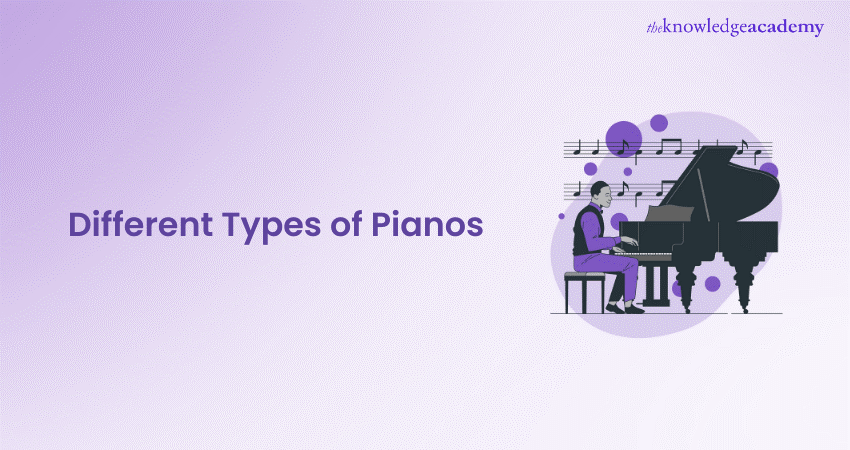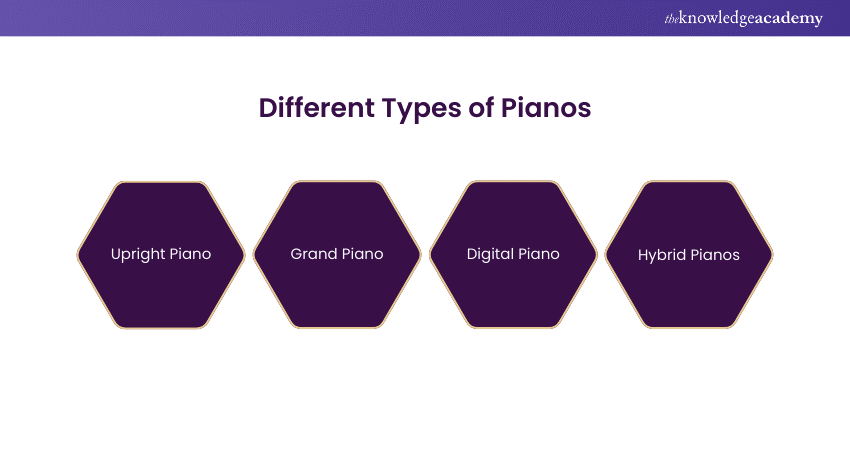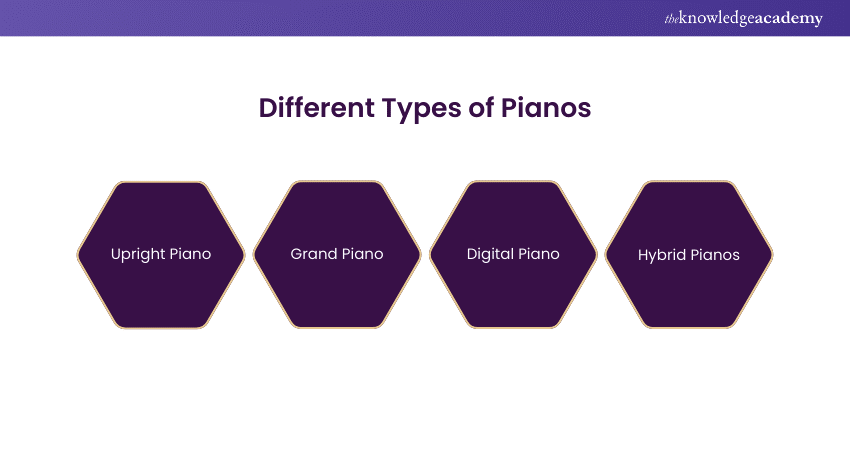We may not have the course you’re looking for. If you enquire or give us a call on +65 6929 8747 and speak to our training experts, we may still be able to help with your training requirements.
Training Outcomes Within Your Budget!
We ensure quality, budget-alignment, and timely delivery by our expert instructors.

The Piano is a keyboard-based musical instrument that creates sounds by striking strings with a hammer through a manual keyboard. It is one of the most widely used musical instruments in classical, jazz, traditional and popular music for solo, ensemble, chamber music and others. To cater all types of music, there are so many Different Types of Pianos out there, each differ from sounds, size and systems. However, it is difficult to pick the right one. Hence, you first need to understand the different Piano types that exist. To learn more about the best Types of Pianos and how they work, read the blog.
Table of Contents
1) Different Types of Pianos
a) Upright Piano
b) Grand Piano
c) Electronic/Digital Piano
d) Hybrid Pianos
2) Conclusion
Different Types of Pianos
There are Different Types of Pianos used for different occasions, each varying in size and shape, sounds and other features. With the ongoing technological developments, the Piano has been developed in electric, electronic, digital, and acoustic forms. Let's explore the Piano Types before you purchase one. Here's a detailed overview:

Upright Piano
Upright Piano is the most popular Acoustic Piano worldwide. It is mostly used in churches, schools, music conservatories, and university music functions. This Piano is sleek and requires less space, hence, favourable for homes. There are mainly four Types of Upright Piano. So, let's dive in to know more:
a) Spinet Piano: Spinet Piano is one of the most popular variants of Upright Piano. It is usually 35-40 inches tall and good for beginners and amateur players. At present, Spinet Piano is not being manufactured, but you can still find it in stores and some homes.
b) Studio Piano: Studio Piano is used for music compositions and can be found in music schools and recording studios. The standard size of this Piano ranges from 43 to 47 inches. It comes in both electric and acoustic setups.
c) Console Piano: Console Piano is made with better key-hammer mechanisms. It is bigger than the size of a Spinet Piano. The size ranges from 40 to 44 inches. It is mostly used in sound designing studios.
Grand Piano
The Grand Piano, also known as the Horizontal Piano, is one of the most popular and beautiful Types of Pianos. It is more expensive than the Upright Piano. It is used for concerts, live performances, and music composition.
Musicians prefer the Grand Piano as it has the most beautiful sound of all. It contains 88 keys (52 white and 36 black). Grand Piano comes in various sizes. To know more about these variants, let's read ahead:
a) Petite Grand Piano: Petite Grand Piano is the smallest among all the horizontal Pianos. It impresses musicians with its powerful sound. It comes with a length of 4 feet 5 inches to 4 feet 11 inches. Petite Grand sounds like Upright Piano and is ideal for small rooms.
b) Parlor Grand Piano: Parlor Grand Piano is often known as living room piano. It comes with excellent tonal characteristics and can fill a large living room or concert hall. The size ranges from 6 feet 3 inches to 6 feet 10 inches.
c) Baby Grand Piano: Baby Grand Piano is also ideal for domestic use in small living rooms. It comes with a good balance of size, tonal richness, and volume output for small places. The standard size measures between 5 feet to 5 feet 5 inches.
d) Concert Grand Piano: Concert Grand Piano is the most important variant of the Grand Piano family. It usually comes with 9 inches. It is used by professionals in orchestras and music halls. It offers the largest volume output, richest tonal capabilities and balanced sound.
e) Medium Grand Piano: Medium Grand Piano is also known as classical Grand Piano. It is mainly used in living rooms or tiny concert places. The standard size ranges from 5 feet 6 inches and 5 feet 8 inches.
f) Professional Grand Piano: Professional Grand Piano is one of the best in tonal performance. The length of Professional Grand Piano is around 6 inches. It is mainly used by professional players in concert halls and large living rooms.
g) Semi-Concert Grand Piano: Semi-Concert Grand Piano is also called ballroom Grand Piano. Due to its powerful sound, it is ideal for concert venues and music halls. It is one of the largest Grand Pianos, which comes 7 feet in length.
Enhance your knowledge in Filmmaking with our Filmmaking Masterclass - sign up now!
Electronic/Digital Piano
Electronic/Digital Pianos are the most recent variants of Pianos. These are often lightweight and portable. Electronic Pianos are designed to serve as an alternative to traditional Acoustic Pianos.
They do not have pedals like traditional ones and are used in recording studios, live concerts, and practice sessions. These also come in three different variants. Let's find out more about these variants:

a) Electric Piano: Electric Piano, invented by Harold Rhodes, was quite popular during 70s. It usually has 73 keys instead of 88. It comes with thin metal tines rather than strings to produce the sound. It is picked up by an electromagnetic pickup and then travels through an amplifier and speaker.
b) Digital Piano: Digital piano was invented by Yamaha in 1983. It saves and loads songs and connects to a computer via USB or Wi-Fi. It gives you the feel of a Grand Piano. Digital Piano has weighted keys or graded hammers and has been named and renamed over the years.
c) Keyboard: The Keyboard is designed for beginners to play at home. It is manufactured with a low-watt amp and speakers. It is lightweight and has 91 to 78 keys.
Learn how to play Keyboard with our Keyboard Instrument Course - join today!
Hybrid Pianos
Hybrid Piano was designed in the early 2000s with the fusion of acoustic and digital Piano elements. It can be like Upright, Baby Grand, or Grand Piano, but with a Musical Instrument Digital Interface (MIDI) unit. There are three main variants of Hybrid Pianos. These variants are listed below:
a) The Toy Piano: The Toy Piano, also known as the Kinderklavier, is a small Piano style musical instrument. It comes with round metal rods instead of strings like a regular Piano to produce sound.
b) Silent Piano: Silent Piano is an Acoustic Piano with an option to have silent private practice. The sensors pick up the Piano key element and convert it to a MIDI signal that can be sent to sound module.
c) Player Piano: Player Piano, known as a Pianola, is a self-playing piano that uses a pneumatic or electro-mechanical mechanism. It operates the Piano action through perforated paper or metallic rolls.
Conclusion
We hope this blog made you understand the Different Types of Pianos and their variants available in the market. From Upright to Grand to Electronic/Digital Piano, it comes in different designs, styles, shapes and sizes. Further, it may have helped you to figure out which one suits your requirements and budget.
Master your Piano Skills with our Piano Course - register today!
Frequently Asked Questions

A standard 88-key Piano is ideally the best choice for professionals as well as beginners. However, this could be a little expensive. So, it is advisable for you to buy 66 keys Piano, which is comparatively cheaper.

It depends on the individual’s preference. At present, Digital Pianos can create the same sound as Acoustic Pianos. However, many Pianists feel that acoustic pianos are better than digital pianos. You can select whichever you like and that suits your budget and needs.

The Knowledge Academy takes global learning to new heights, offering over 30,000 online courses across 490+ locations in 220 countries. This expansive reach ensures accessibility and convenience for learners worldwide.
Alongside our diverse Online Course Catalogue, encompassing 17 major categories, we go the extra mile by providing a plethora of free educational Online Resources like News updates, Blogs, videos, webinars, and interview questions. Tailoring learning experiences further, professionals can maximise value with customisable Course Bundles of TKA.

The Knowledge Academy’s Knowledge Pass, a prepaid voucher, adds another layer of flexibility, allowing course bookings over a 12-month period. Join us on a journey where education knows no bounds.

The Knowledge Academy offers various Hobbies and Interests courses, including a Piano Course, Guitar Course, and Music Production Course. These courses cater to different skill levels, providing comprehensive insights into Careers in Music Production.
Our Business Skills Blogs cover a range of topics related to musical instruments, offering valuable resources, best practices, and industry insights. Whether you are a beginner or looking to advance your skills as a Music Producer, The Knowledge Academy's diverse courses and informative blogs have you covered.







 Top Rated Course
Top Rated Course




 If you wish to make any changes to your course, please
If you wish to make any changes to your course, please


